Related Research Articles
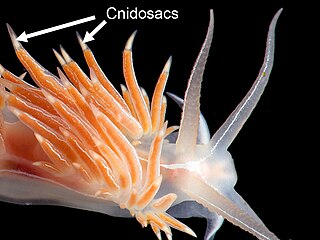
Cerata, singular ceras, are anatomical structures found externally in nudibranch sea slugs, especially in aeolid nudibranchs, marine opisthobranch gastropod mollusks in the clade Aeolidida. The word ceras comes from the Greek word "κέρας", meaning "horn", a reference to the shape of these structures.
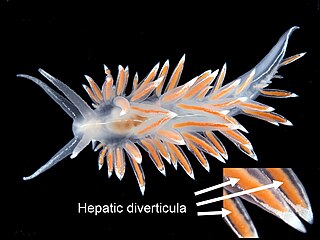
As applied to mollusks, the New Latin term diverticulum is an anatomical feature. The term is most often encountered in the plural form as "diverticula", "hepatic diverticula", or "digestive diverticula", which are anatomical terms for organs which are visible from the outside of the body in a clade of sea slugs known as aeolid nudibranchs, marine opisthobranch gastropod molluscs.

Godiva quadricolor is a species of sea slug, a nudibranch, a shell-less marine gastropod mollusc in the family Facelinidae.

The purple lady nudibranch, Paraflabellina funeka, is a species of aeolid nudibranch, and is a very colourful sea slug. It is a marine gastropod mollusc in the family Flabellinidae.

The white-edged nudibranch, Fjordia capensis, is a species of sea slug, specifically an aeolid nudibranch, a very colourful sea slug. It is a marine gastropod mollusc in the family Flabellinidae.

Trinchesia speciosa, common name the "candy nudibranch", is a species of sea slug, an aeolid nudibranch, a marine gastropod mollusc in the family Trinchesiidae.
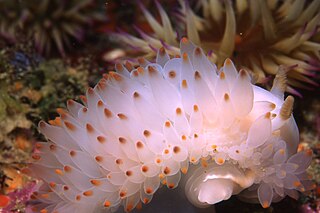
The gasflame nudibranch is a very colourful species of nudibranch, or sea slug. It is a marine gastropod mollusc in the family Proctonotidae. Bonisa nakaza is the only species in the genus Bonisa.
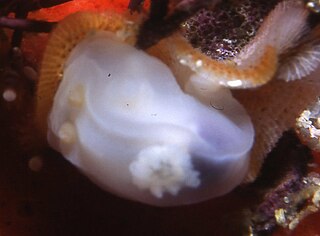
The ghost nudibranch, Lecithophorus capensis, is a species of dorid nudibranch, and is only found in South Africa. It is a marine gastropod mollusc in the family Polyceridae. It is the sole species of the genus Lecithophorus.
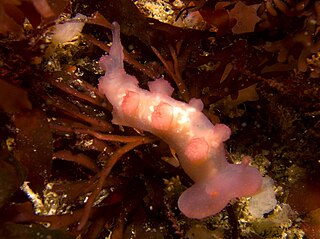
Melibe rosea, the cowled nudibranch, is a species of sea slug, a dendronotid nudibranch, a marine gastropod mollusc in the family Tethydidae.

Janolus capensis, the Cape silvertip nudibranch, is a beautiful species of nudibranch, or sea slug. It is a marine gastropod mollusc in the family Proctonotidae.

Janolus longidentatus, the medallion silvertip nudibranch, is a spectacular-looking species of nudibranch, or sea slug. It is a marine gastropod mollusc in the family Proctonotidae.
The yellow-tipped nudibranch, Caloria sp. 2, as designated by Gosliner, 1987, is a species of sea slug, specifically an aeolid nudibranch, a marine gastropod mollusc in the family Facelinidae.
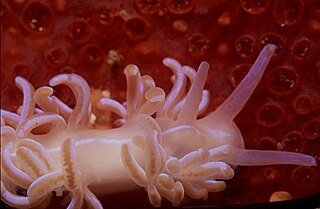
Phyllodesmium horridum, the coral nudibranch, is a species of sea slug, specifically an aeolid nudibranch. It is a marine gastropod mollusc in the family Facelinidae.
Amanda armata, the night sky nudibranch, is a species of sea slug, specifically an aeolid nudibranch. It is a marine gastropod mollusc in the family Facelinidae.

The orange-eyed nudibranch, scientific name Cratena capensis, is a species of sea slug, specifically an aeolid nudibranch. It is a marine gastropod mollusc in the family Facelinidae.
The fireworks nudibranch, Eubranchus sp. 4, as designated by Zsilavecz, 2007, is a species of sea slug or nudibranch, a marine gastropod mollusc in the family Eubranchidae. It is an aeolid nudibranch, which is known to occur off the South African coast. As at August 2010, it remained undescribed by science.
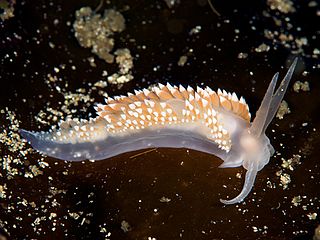
Coryphella verrucosa, is a species of sea slug, an aeolid nudibranch, a marine gastropod mollusc in the family Flabellinidae. It is found on either side of the northern part of the Atlantic Ocean.

A cnidosac is an anatomical feature that is found in the group of sea slugs known as aeolid nudibranchs, a clade of marine opisthobranch gastropod molluscs. A cnidosac contains cnidocytes, stinging cells that are also known as cnidoblasts or nematocysts. These stinging cells are not made by the nudibranch, but by the species that it feeds upon. However, once the nudibranch is armed with these stinging cells, they are used in its own defense.
Calmella gaditana is a species of sea slug, an aeolid nudibranch, a marine gastropod mollusk in the family Flabellinidae.
Anteaeolidiella saldanhensis, is a species of sea slug, an aeolid nudibranch. It is a shell-less marine gastropod mollusc in the family Aeolidiidae.
References
- ↑ Gosliner, T. M. 1987. Nudibranchs of Southern Africa ISBN 0-930118-13-8
- ↑ Zsilavecz, G. 2007. Nudibranchs of the Cape Peninsula and False Bay. ISBN 0-620-38054-3